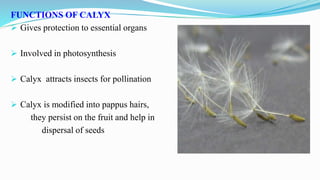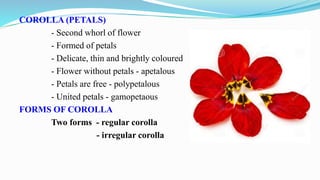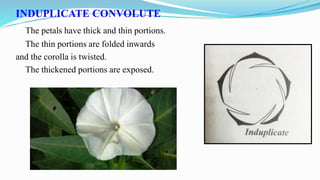Floral parts
- 1. R. NITHYA M. Sc., M. Phil., (Ph. D) ASSISTANT PROFESSOR IN BIOTECHNOLOGY SRI ADI CHUNCAHNAGIRI WOMEN’S COLLEGE, CUMBUM, THENI DT
- 2. FLOWER Flower is the reproductive part of Angiosperms. It is a modified vegetative shoot. Flower consist four parts - Calyx - Corolla - Androecium -Gynoecium
- 3. PARTS OF FLOWER The flower consists two parts Non Essential parts - Calyx - Corolla Essential parts - Androecium - Gynoecium Non Essential Parts Essential Parts
- 4. ARRANGEMENT OF FLORAL PARTS A flower consist of a very shot axis, called thalamus. Flower has four floral whorls arranged on the thalamus - Outermost whorl - Calyx (Sepal) - Outer whorl - Corolla (Petal) - Inner whorl - Androecium (Male) - Innermost whorl - Gynoecium (female) Base of the flower called receptacle
- 5. PERIANTH The non-essential parts of the flower are together called perianth. The units of perianth is called tepal Tepals free – polyphyllous Tepals united - gamophyllous
- 6. CALYX - Outermost whorl - Formed of sepal Sepals are free - polysepalous Sepals are united - gamosepalous
- 7. SEPALS In some plants, the sepals are brightly coloured and petaloid. Leaf like sepals- whitish or yellowish
- 8. Pappus hair like sepal
- 10. DURATION OF THE CALYX CADUCOUS – e. g Argemone. Sepals fall off as soon as the flower opened out.
- 11. DECIDUOUS – MUSTARD The sepals fall off at the same time as the corolla.
- 12. PERSISTANT - BRINJAL The sepal remain without falling and are found on the fruit.
- 13. ACCRESCENT – PHYSALIS The calyx is not only persistent, but forms an loose envelope around the fruit.
- 14. FUNCTIONS OF CALYX Gives protection to essential organs Involved in photosynthesis Calyx attracts insects for pollination Calyx is modified into pappus hairs, they persist on the fruit and help in dispersal of seeds
- 15. COROLLA (PETALS) - Second whorl of flower - Formed of petals - Delicate, thin and brightly coloured - Flower without petals - apetalous - Petals are free - polypetalous - United petals - gamopetaous FORMS OF COROLLA Two forms - regular corolla - irregular corolla
- 16. POLYPETALOUS AND REGULAR COROLLA CRUCIFORM COROLLA The corolla has four free and calwed petals.
- 17. ROSACEOUS COROLLA The corolla consists five spreading lobes and not clawed. E.g. Rosa
- 18. CARYOPHYLLOUS COROLLA The corolla consists of four free and calwed petals with spreading lobes. E.g. Dianthus
- 19. POLYPETALOUS AND IRREGULAR COROLLA PAPILIONACEOUS COROLLA The corolla consists five free and unequal petals One posterior standard petal or vexillum Two lateral petals - alae or wing petals Twoanterior petals - carinae or keel petals E.g. Fabaceae or Papilionaceae
- 20. GAMOPETALOUS AND REGULAR COROLLA Tubular corolla The petals are united to form a tube like structure. E.g. Disc florets of Helianthus
- 21. CAMPANULATE OR BELL SHAPED COROLLA The corolla is bell shaped E.g. Physalis
- 22. INFUNDIBULIFORM OR FUNNEL SHAPED The corolla is funnel shaped E.g. Datura
- 23. ROTATE OR WHEEL SHAPED Corolla is wheel shaped with short corolla tube.
- 24. HYPOCRATE FORM OR SALVER SHAPED The corolla has a narrow tube and the limbs are attached at right angle. E.g. Vinca
- 25. GAMOPETALOUS AND IRREGULAR COROLLA LIGULATE The corolla has a short corolla tube and bears tongue shaped lobes e.g. ray florets of Helianthus
- 26. BILABIATE OR TWO LIPPED COROLLA The corolla has two projecting lips, the upper lip is formed by two petals and the lower lip is formed by the fusion of 3 petals E. g. Leucas, Ocimum The throat of the corolla is always open
- 27. PERSONATE The corolla is having two lips, but the lips are so close to one another that the throat of the corolla remains always closed.
- 28. AESTIVATION Arrangement of petals and sepals
- 29. TYPES OF AESTIVATION Valvate Twisted or contorted Imbricate Quincuntial Vexillary Induplicate Induplicate convolute
- 30. VALVATE Petals or sepals just touching with one another without overlapping
- 31. TWISTED OR CONTORTED The sepals or petals are over lapping with one another at the margins
- 32. IMBRICATE The sepals or petals are overlapping one another in an irregular manner.
- 33. QUINCUNTIAL IMBRICATE The margins of two sepals – towards inward The margins of other two petals – outward The remaining one petal one margin is towards innerside other margin is towards the outside
- 34. VEXILLARY The imbricate aestivation of papilionaceous corolla is termed as vexillary aestivation. There are two types of imbricate aestivation Ascendingly imbricate Decendingly imbricate
- 35. ASCENDINGLY IMBRICATE The closure of the margins are from Anterior side(lower side) to the posterior side of (upper side) the flower. DECENDINGLY IMBRICATE Margin of standard petal – Towards outside Margin of two keel petals- Towards innerside One margin of wing petals is Towards outside One margin of wing petals is Towards innerside
- 36. INDUPLICATE The petals or sepals are folded inwards.
- 37. INDUPLICATE CONVOLUTE The petals have thick and thin portions. The thin portions are folded inwards and the corolla is twisted. The thickened portions are exposed.





































